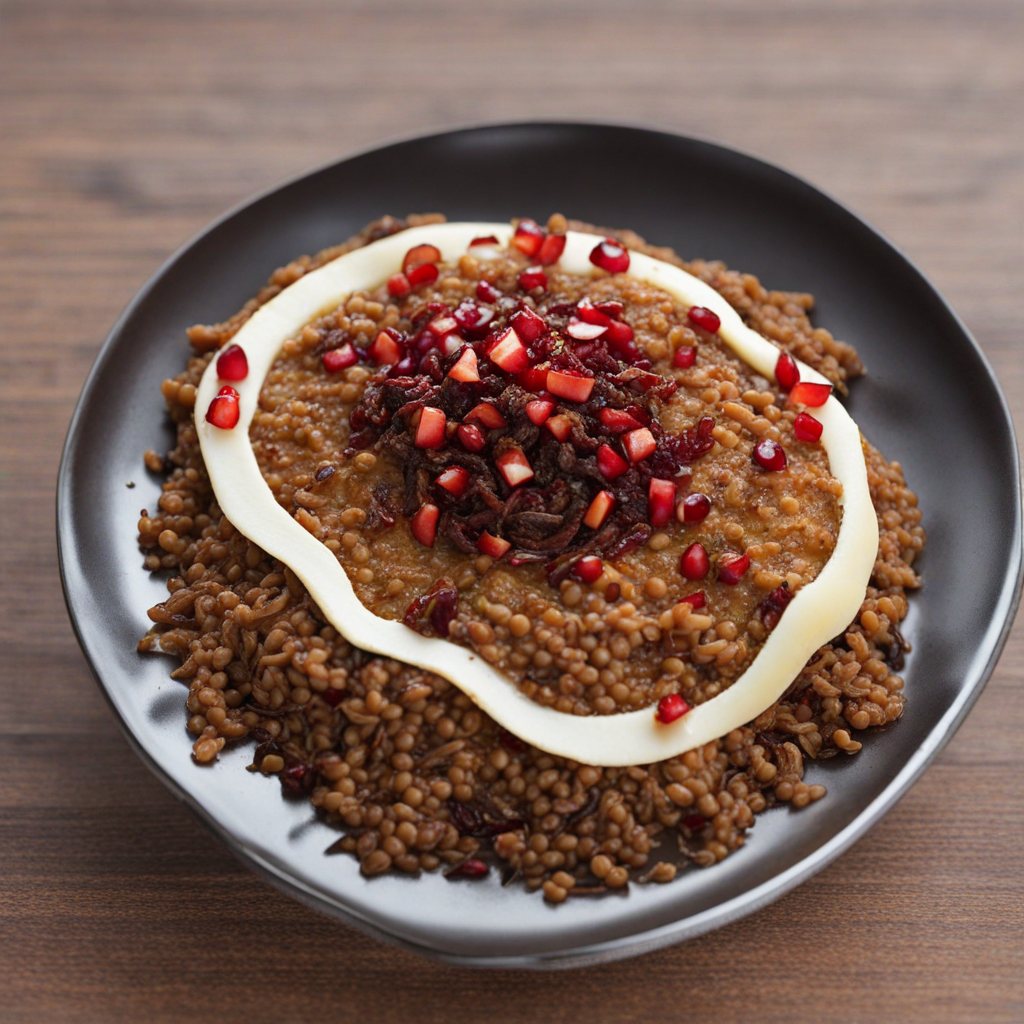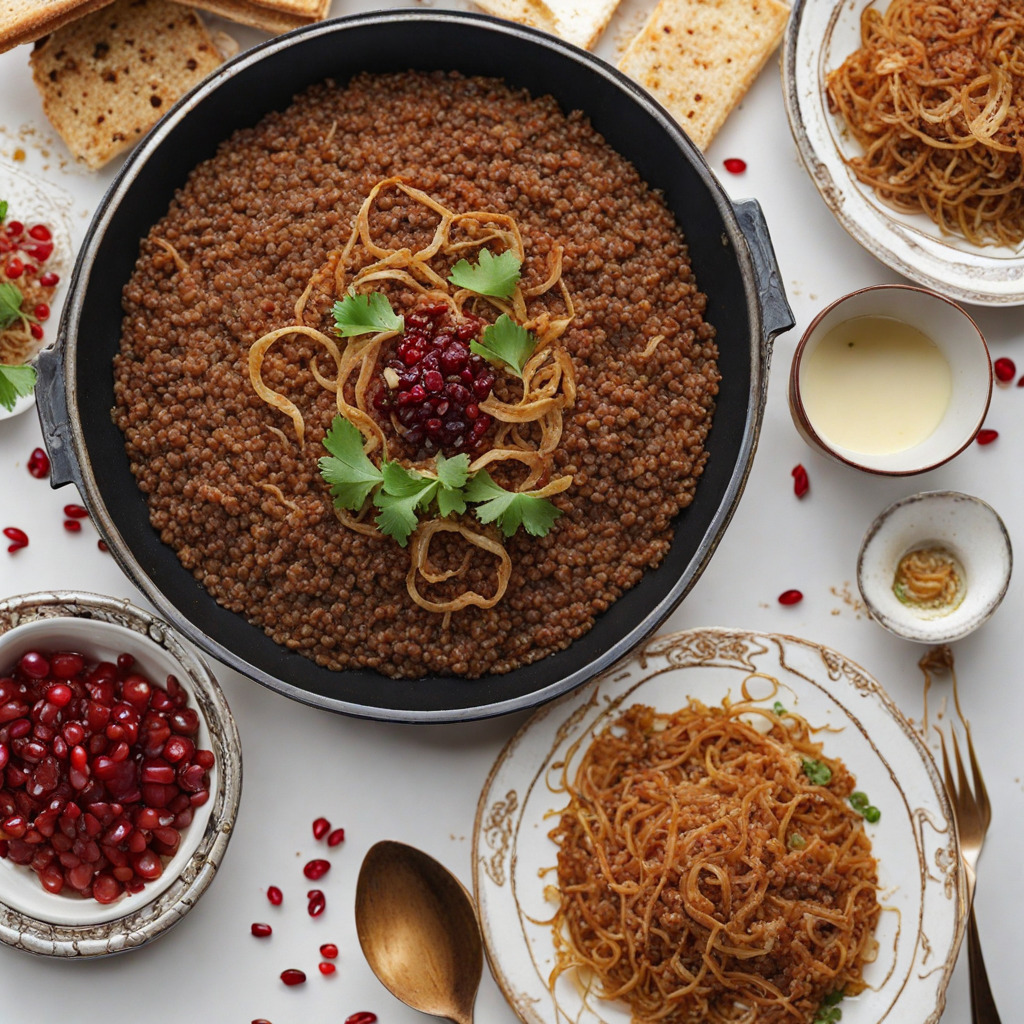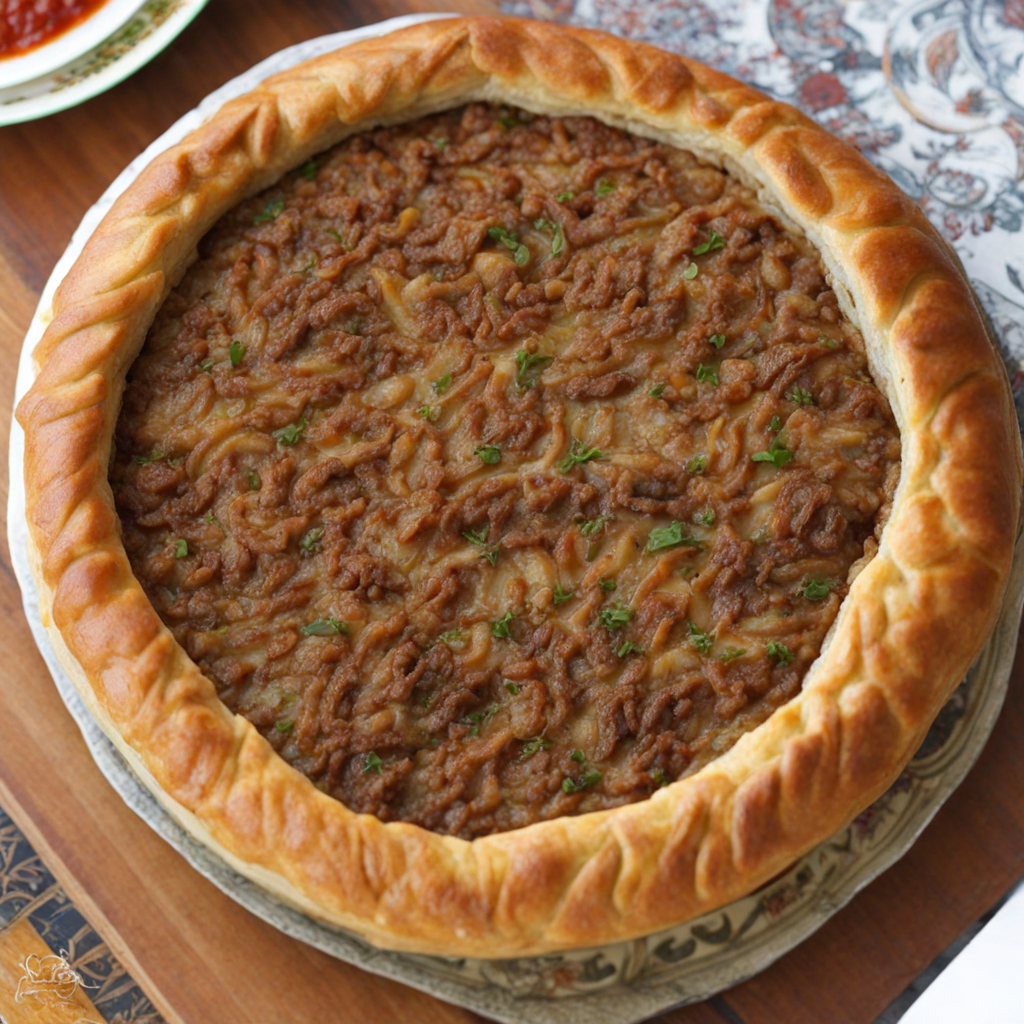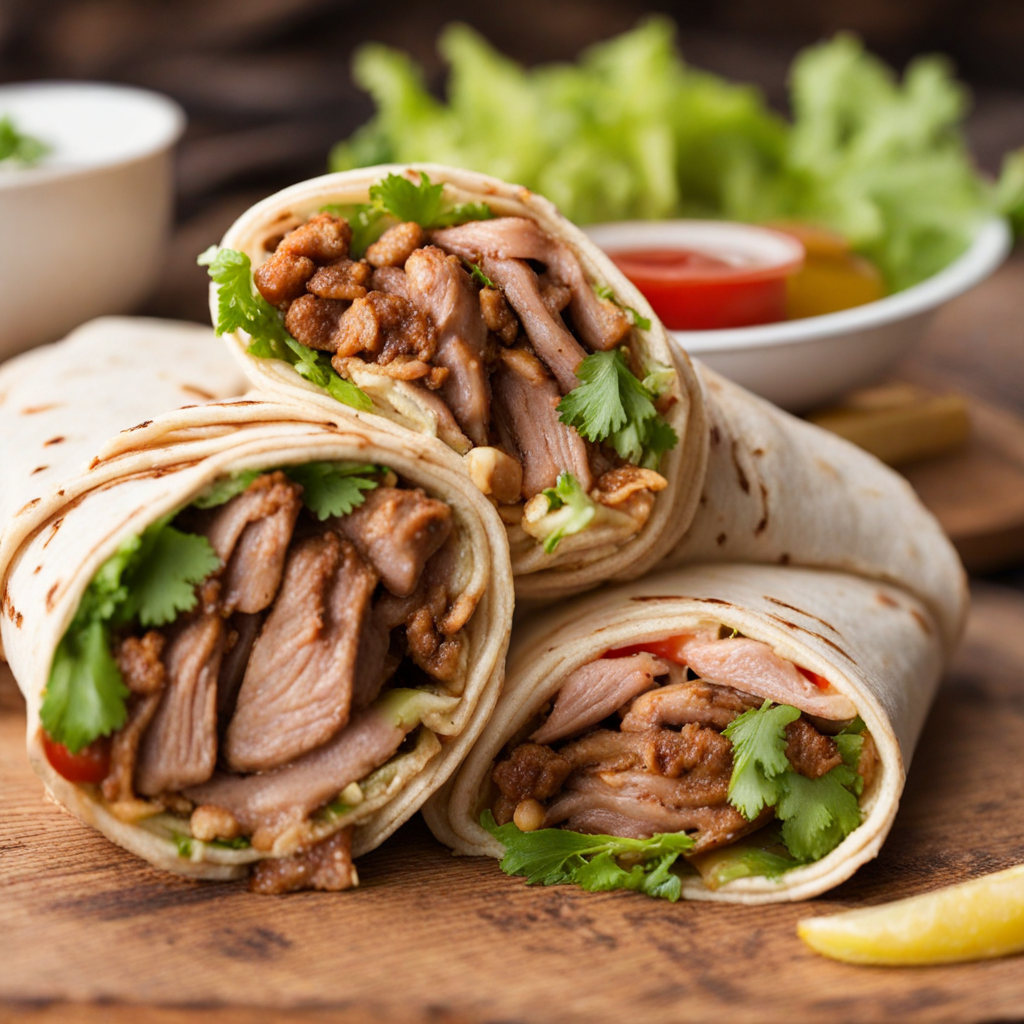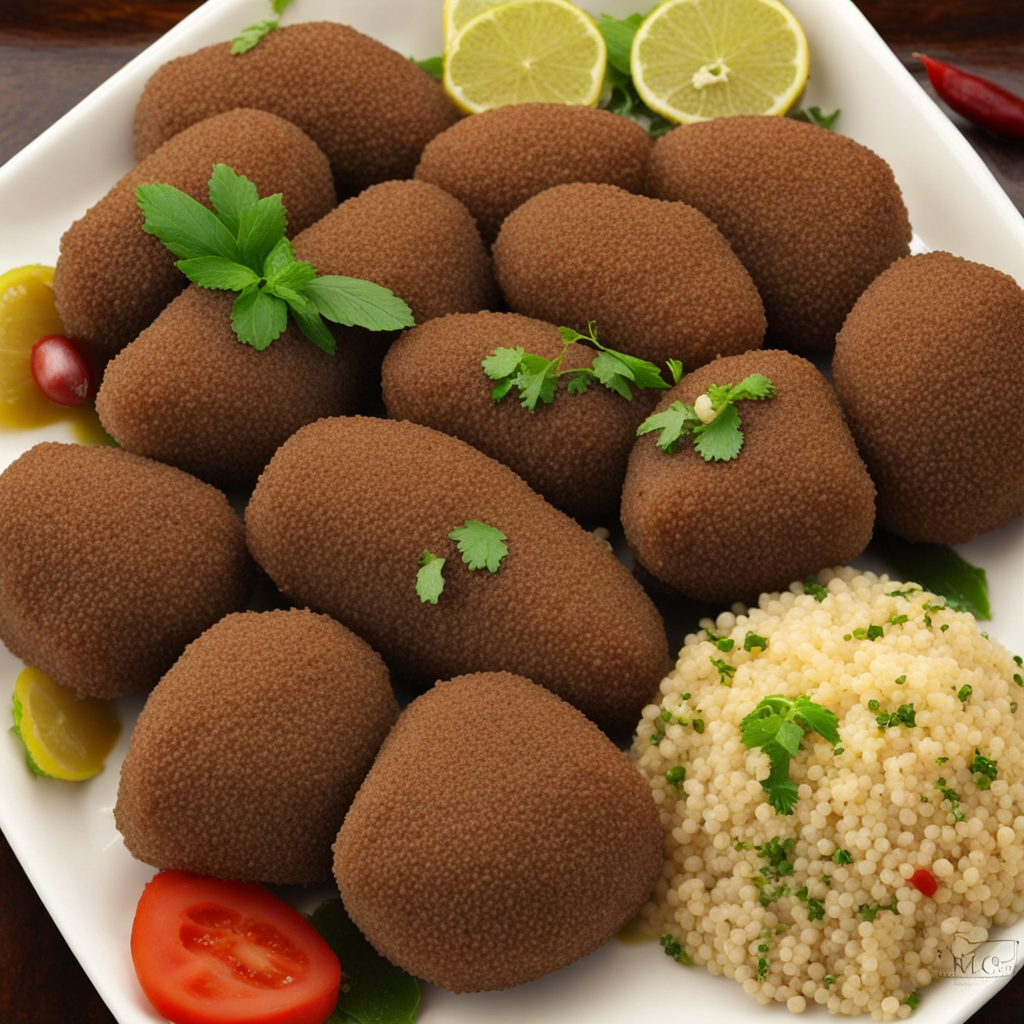Harraq Osbao
Harraq Osbao is a delightful Syrian dish that embodies the rich culinary traditions of the region. This hearty meal consists primarily of tender lamb or beef, which is slowly simmered until it becomes melt-in-your-mouth tender. The meat is typically cooked with a medley of spices, including cumin, coriander, and black pepper, which infuse it with a warm and aromatic flavor profile. The addition of roasted pine nuts and a splash of lemon juice at the end gives the dish a delightful crunch and a hint of acidity, balancing the richness of the meat perfectly. What sets Harraq Osbao apart is its unique preparation method, where the meat is often paired with a vibrant tomato-based sauce. The sauce is made with fresh tomatoes, onions, and garlic, creating a comforting and hearty base that envelops the meat. Each ingredient is carefully chosen to enhance the overall flavor, resulting in a dish that is both satisfying and deeply comforting. The use of herbs like parsley or mint as a garnish adds a fresh touch, making the dish visually appealing as well. This dish is typically served over a bed of fluffy rice or alongside crusty bread, allowing you to soak up the delicious sauce. Harraq Osbao is not just a meal; it's an experience that invites you to savor the depth and complexity of Syrian flavors. Sharing this dish with family and friends is a common practice, making it a perfect centerpiece for gatherings and celebrations, showcasing the warmth and hospitality that Syrian cuisine is known for.
How It Became This Dish
The History of حراق اصبعه (Harraqs Isba’a): A Culinary Gem from Syria #### Origins The dish known as حراق اصبعه (Harraqs Isba’a), which translates to "Burnt Fingers," hails from the rich culinary traditions of Syria, a country renowned for its diverse and vibrant gastronomy. The origins of Harraqs Isba’a are rooted in the Levantine cuisine, which combines flavors from Mediterranean, Middle Eastern, and North African cultures. Its name is evocative, hinting at the dish's spicy nature that can make the fingers "burn" with its heat, as well as its method of preparation, which involves frying and sautéing. The dish primarily consists of fried eggplants, which are then simmered in a spicy tomato sauce, often enriched with garlic, chili peppers, and olive oil. Eggplants, or aubergines, have been cultivated in the region for centuries, with evidence of their use dating back to ancient civilizations. Known for their versatility, eggplants are a staple in many Middle Eastern dishes, from stews to dips like baba ghanoush. #### Cultural Significance Harraqs Isba’a is more than just a dish; it is a representation of Syrian hospitality and communal dining. In Syrian culture, food is an integral part of social gatherings and celebrations. Sharing meals with family and friends is a cherished tradition, and dishes like Harraqs Isba’a are often served during communal feasts or family gatherings, showcasing the generosity and warmth of Syrian hospitality. The dish is also significant in the context of Syrian identity. In times of upheaval and conflict, such as the Syrian Civil War that began in 2011, traditional recipes have served as a means of cultural preservation and resistance. For many Syrians, cooking and sharing family recipes have been acts of resilience, allowing them to maintain a connection to their homeland, even in exile. Harraqs Isba’a embodies this spirit, as its preparation often involves multiple generations coming together, sharing stories, and passing down culinary knowledge. #### Development Over Time As with many traditional dishes, the preparation and ingredients of Harraqs Isba’a have evolved over time. The classic version of the dish features simple ingredients that are easily accessible in the region, but variations have emerged based on local tastes and available resources. For instance, while the base of fried eggplants and tomato sauce remains constant, some families may incorporate additional ingredients such as ground beef or lamb, chickpeas, or even an array of spices like cumin and coriander, depending on regional preferences. The rise of globalization and the migration of Syrian communities worldwide have also influenced the evolution of Harraqs Isba’a. As Syrians have settled in countries across Europe, North America, and beyond, they have adapted the dish to include locally available ingredients. For example, in parts of the United States, it may incorporate different types of peppers or herbs not traditionally used in Syria. This adaptability has allowed Harraqs Isba’a to maintain its relevance in contemporary cuisine, appealing to new palates while staying true to its roots. #### Cooking Techniques and Presentation The preparation of Harraqs Isba’a is an art that reflects both skill and tradition. The dish typically starts with the careful selection of eggplants, which are often sliced and salted to draw out moisture and bitterness before frying. This technique not only enhances the flavor but also contributes to the dish's signature texture. The eggplants are then fried to a perfect golden brown, achieving a balance between crispness and tenderness. The sauce, which is a crucial component of Harraqs Isba’a, is made by sautéing garlic and chili peppers in olive oil, followed by the addition of fresh tomatoes or tomato paste. This rich sauce is then combined with the fried eggplant, allowing the flavors to meld together. The dish is often garnished with fresh herbs, such as parsley or cilantro, adding a burst of color and freshness. Traditionally served in a communal bowl, Harraqs Isba’a is intended to be enjoyed family-style, encouraging diners to help themselves and share the experience. Accompanying the dish, you might find warm pita bread, which is perfect for scooping up the delicious eggplant and sauce. #### Modern Interpretations and Global Influence In recent years, Harraqs Isba’a has gained recognition beyond its regional origins, particularly as interest in Middle Eastern cuisine has surged globally. Food enthusiasts and chefs have begun to showcase this dish in culinary festivals, restaurants, and cookbooks, highlighting its unique flavors and cultural significance. In the modern culinary landscape, Harraqs Isba’a is often adapted to cater to contemporary dietary preferences, including vegetarian and vegan diets. With the growing popularity of plant-based eating, many chefs have reinterpreted the dish by emphasizing its vegetable components while reducing or omitting animal products. This not only broadens its appeal but also showcases the dish’s inherent versatility. Moreover, the global interest in authenticity and traditional cooking has led to a resurgence in the appreciation of Harraqs Isba’a as a symbol of Syrian heritage. Cookbooks focusing on Syrian cuisine now feature Harraqs Isba’a prominently, often accompanied by personal anecdotes from families who have cherished the dish for generations. This documentation not only preserves the recipe but also tells the stories of those who have made it a part of their culinary legacy. #### Conclusion Harraqs Isba’a stands as a testament to Syria's rich culinary heritage, embodying the flavors, traditions, and resilience of its people. As it continues to evolve, this beloved dish not only tantalizes the taste buds but also serves as a reminder of the importance of family, community, and cultural identity. Whether enjoyed in a bustling Syrian kitchen or a modern restaurant thousands of miles away, Harraqs Isba’a remains a cherished symbol of a nation's history, serving as a bridge between the past and the present, and a flavorful connection to a shared human experience.
You may like
Discover local flavors from Syria


